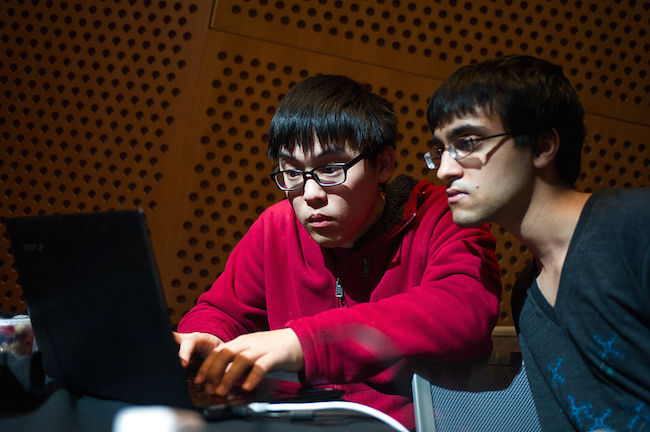Uproxx knows that science, technology, engineering, and math (STEM) disciplines are driving the future of this planet forward. Every day, we see new ideas, fresh innovations, and bold trailblazers in these fields. Follow us this month as we highlight how STEM is shaping the culture of NOW.
Everyone and their mother uses the internet. Hell, even North Korea uses some kind of internet. Which means everyone and their mothers, along with North Korea, are susceptible to privacy breaches and hacking. Buying stuff, “checking in” at Standing Rock, enrolling in newsletters, and connecting your phone to your home’s security system — it all makes you vulnerable. And try as you might to reject all notions of vulnerability, you’re in need of a hero.
A whole new generation of heroes, in fact — a fresh wave of IT and cyber security students from around the country. The trouble is, it can be a challenge to find those students.
As you probably know — because you’re damn sure not reading this in print — science, technology, engineering, and math (STEM) are absolutely integral to everyday life. In an increasingly tech driven world, it goes without saying that STEM is the future. However, companies in the industry are struggling to find workers skilled enough to fill vacant employment positions. Almost half of ACT-tested students (1 million) graduating in 2016 demonstrated an interest in stem and the rate of attrition for STEM majors was lower (48%) than most other non-STEM fields (56-62%) — still it’s hard to keep up with demand, especially with weak or underdeveloped programs at the elementary, middle, and high school levels.
A lack of student interest has inspired many companies and organizations to produce creative initiatives that promote STEM. One idea that’s managed to attract the ever elusive interest of young people are cyber security competitions — that’s where those aforementioned heroes come in. In these competitions, teams of middle school and high school students become pseudo-IT professionals. They are challenged to strengthen and defend simulated computer networks, find cybersecurity vulnerabilities, and ethically hack connected computer systems. The thinking is that these competitions will provide a venue for students to practice true cyber defense skills, inspiring students to seek degrees and careers in the field.
It appears to be working: One of the country’s largest cyber competitions, Cyberpatriot, has grown nearly 40% each year, with over 3,300 teams across the U.S. and Canada participating.

When Mandy Galante arrived at Red Bank Regional High School (NJ) fifteen years ago as a teacher, the school only offered a two-year Networking course. There was a desire for tech instruction, just no structure in place.
“So I wrote a new two-year curriculum: Intro. to Computer Systems,” she explains. “It teaches how to build and repair computers; and I also wrote a curriculum for Networking, which teaches how to connect computers.”
Focusing on learning a concept, then fortifying it with hands-on experience, Galante’s new classes generated enough student interest for a third-year course — Cybersecurity. It was in response to her students that Galante earned a certification (CompTIA Sec+) to demonstrate her competency and, ultimately, studied for a Master’s degree in Cybersecurity.
While it may be the case that the STEM industry is facing a shortage of prospective employees, Galante hasn’t seen a lack of interest. Exposure and opportunity seem to make all the difference. In fact, students are so passionate about cyber security that the competing schools have had to create mandatory breaks.
“The teams are so intently focused for the six hours of competition time that they won’t take a second for breaks,” Galante says. “We’ve had to make lunch a requirement.”
This April, Red Bank’s “Team Maroon,” finished in second place at Cyberpatriot. For Galante, cybersecurity classes and competitions offer a roadmap for motivated students to find success.
“In many cases, the students have found a path to direct their aspirations after high school,” she says. “A path that will reliably lead them to productive and well-paying careers.”
While competitions and new class offerings are vital to ensuring that STEM fields will continue to draw qualified and engaged young minds, there’s one area where improvement is still needed. Asked what she thinks about the lack of girls and women in STEM fields, Galante tells us plainly, “It drives me crazy!” She says girls in her high school won’t even give her Intro class a try and, until two years ago, they’d never had a girl on the school’s cyber security competition team.
After concluding that girls avoid STEM fields even before finishing middle school, Galante decided to develop a cyber security competition team at the middle school level. So far, it’s been a smashing success. Six out of the nine team members are girls. Galante hopes to see that excitement transfer to the older kids.
“My cyber security class at the high school has 29 students,” she says, “with only three girls. The Cyberpatriot teams have 36 total students, with only three girls.”
Recently, Galante has focused her energy on connecting girls with tech outside of school, partnering with the local community college to run summer camps for underrepresented populations in technology including females, African Americans, and Latinos. The camp is free to students, and funded by a grant written with the NSA.
As Galante’s efforts reveal, the world is rapidly changing how it approaches STEM. Organizations like the Girl Scouts are integrating new STEM learning opportunities, and colleges are connecting with younger students to promote STEM disciplines. Each day, more and more students are seeing that the future is bright and the opportunities for employment are literally endless.
